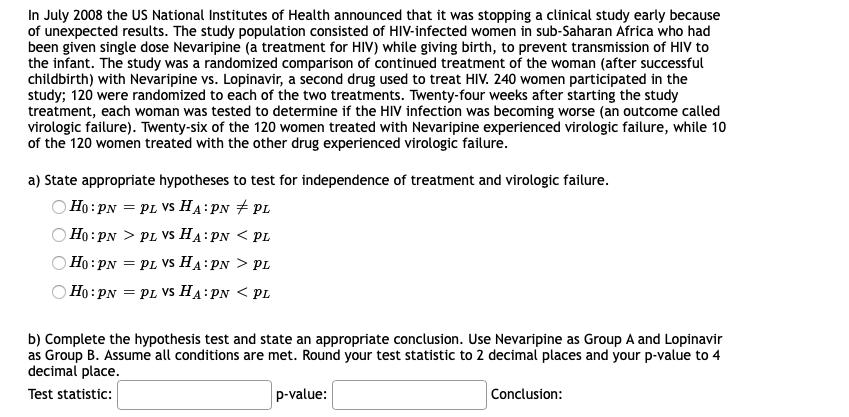In July 2008 the US National Institutes of Health announced that it was stopping a clinical study early because of unexpected results. The study population consisted of HIV-infected women in sub-Saharan Africa who had been given single dose Nevaripine (a treatment for HIV) while giving birth, to prevent transmission of HIV to the infant. The study was a randomized comparison of continued treatment of the woman (after successful childbirth) with Nevaripine vs. Lopinavir, a second drug used to treat HIV. 240 women participated in the study; 120 were randomized to each of the two treatments. Twenty-four weeks after starting the study treatment, each woman was tested to determine if the HIV infection was becoming worse (an outcome called virologic failure). Twenty-six of the 120 women treated with Nevaripine experienced virologic failure, while 1o of the 120 women treated with the other drug experienced virologic failure. a) State appropriate hypotheses to test for independence of treatment and virologic failure. Họ : PN = PL VS HA:PN + PL Ho: PN > PL VS HA:PN < PL Ho: PN = PL VS HA:PN > PL Họ : PN = PL VS HA:PN < PL b) Complete the hypothesis test and state an appropriate conclusion. Use Nevaripine as Group A and Lopinavir as Group B. Assume all conditions are met. Round your test statistic to 2 decimal places and your p-value to 4 decimal place. p-value: Test statistic: Conclusion:
In July 2008 the US National Institutes of Health announced that it was stopping a clinical study early because of unexpected results. The study population consisted of HIV-infected women in sub-Saharan Africa who had been given single dose Nevaripine (a treatment for HIV) while giving birth, to prevent transmission of HIV to the infant. The study was a randomized comparison of continued treatment of the woman (after successful childbirth) with Nevaripine vs. Lopinavir, a second drug used to treat HIV. 240 women participated in the study; 120 were randomized to each of the two treatments. Twenty-four weeks after starting the study treatment, each woman was tested to determine if the HIV infection was becoming worse (an outcome called virologic failure). Twenty-six of the 120 women treated with Nevaripine experienced virologic failure, while 1o of the 120 women treated with the other drug experienced virologic failure. a) State appropriate hypotheses to test for independence of treatment and virologic failure. Họ : PN = PL VS HA:PN + PL Ho: PN > PL VS HA:PN < PL Ho: PN = PL VS HA:PN > PL Họ : PN = PL VS HA:PN < PL b) Complete the hypothesis test and state an appropriate conclusion. Use Nevaripine as Group A and Lopinavir as Group B. Assume all conditions are met. Round your test statistic to 2 decimal places and your p-value to 4 decimal place. p-value: Test statistic: Conclusion:
MATLAB: An Introduction with Applications
6th Edition
ISBN:9781119256830
Author:Amos Gilat
Publisher:Amos Gilat
Chapter1: Starting With Matlab
Section: Chapter Questions
Problem 1P
Related questions
Question

Transcribed Image Text:In July 2008 the US National Institutes of Health announced that it was stopping a clinical study early because
of unexpected results. The study population consisted of HIV-infected women in sub-Saharan Africa who had
been given single dose Nevaripine (a treatment for HIV) while giving birth, to prevent transmission of HIV to
the infant. The study was a randomized comparison of continued treatment of the woman (after successful
childbirth) with Nevaripine vs. Lopinavir, a second drug used to treat HIV. 240 women participated in the
study; 120 were randomized to each of the two treatments. Twenty-four weeks after starting the study
treatment, each woman was tested to determine if the HIV infection was becoming worse (an outcome called
virologic failure). Twenty-six of the 120 women treated with Nevaripine experienced virologic failure, while 1o
of the 120 women treated with the other drug experienced virologic failure.
a) State appropriate hypotheses to test for independence of treatment and virologic failure.
Ho : PN = PL VS HA:PN + PL
Ho: PN > PL VS HA:PN < PL
Ho: PN = PL VS HA:PN > PL
Ho :PN = PL VS HA:PN < PL
b) Complete the hypothesis test and state an appropriate conclusion. Use Nevaripine as Group A and Lopinavir
as Group B. Assume all conditions are met. Round your test statistic to 2 decimal places and your p-value to 4
decimal place.
Test statistic:
p-value:
Conclusion:
Expert Solution
This question has been solved!
Explore an expertly crafted, step-by-step solution for a thorough understanding of key concepts.
This is a popular solution!
Trending now
This is a popular solution!
Step by step
Solved in 3 steps with 3 images

Recommended textbooks for you

MATLAB: An Introduction with Applications
Statistics
ISBN:
9781119256830
Author:
Amos Gilat
Publisher:
John Wiley & Sons Inc

Probability and Statistics for Engineering and th…
Statistics
ISBN:
9781305251809
Author:
Jay L. Devore
Publisher:
Cengage Learning

Statistics for The Behavioral Sciences (MindTap C…
Statistics
ISBN:
9781305504912
Author:
Frederick J Gravetter, Larry B. Wallnau
Publisher:
Cengage Learning

MATLAB: An Introduction with Applications
Statistics
ISBN:
9781119256830
Author:
Amos Gilat
Publisher:
John Wiley & Sons Inc

Probability and Statistics for Engineering and th…
Statistics
ISBN:
9781305251809
Author:
Jay L. Devore
Publisher:
Cengage Learning

Statistics for The Behavioral Sciences (MindTap C…
Statistics
ISBN:
9781305504912
Author:
Frederick J Gravetter, Larry B. Wallnau
Publisher:
Cengage Learning

Elementary Statistics: Picturing the World (7th E…
Statistics
ISBN:
9780134683416
Author:
Ron Larson, Betsy Farber
Publisher:
PEARSON

The Basic Practice of Statistics
Statistics
ISBN:
9781319042578
Author:
David S. Moore, William I. Notz, Michael A. Fligner
Publisher:
W. H. Freeman

Introduction to the Practice of Statistics
Statistics
ISBN:
9781319013387
Author:
David S. Moore, George P. McCabe, Bruce A. Craig
Publisher:
W. H. Freeman